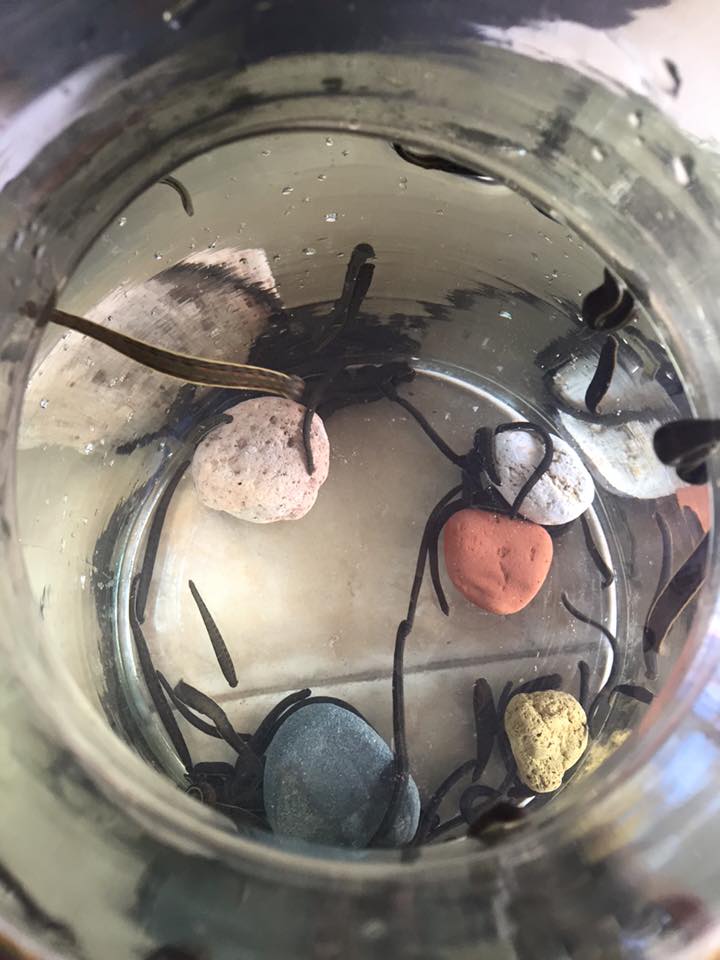
Leech Breeders' Guide to LEECH WATER CHANGING. Leech Care Tips.
Share
Today I am going to show you as my collection has grown bigger how I change my leech water.
I called these “my wild beast” because there are so many of them and and they are just harder to keep up with, when they are so many.
As you can see there is a cloud, there is a cloud of skins inside that bucket of leeches.
They are very very lively and beautiful but they need water changing.
So thats what we are here for.
So all I do is open up my bucket.
I remove all the remaining leeches as you can see now.
You can do a close up and you can see that they are all trying to come out.
And some of them are trying to bite me .
And you have to move very fast if you want this water changing to be effective and if you don’t wanna lose any leeches in sing or in a water or in a carpet.
Hello, all right.
So now that I’ve cleared out my bucked.
I’ve cleared out the sides of the bucket.
I will then use my strainer, my big leech strainer and I will you can zoom out, zoom in and see this skins flooding on the top.
Those skins have to be removed.
If they are not removed leeches will pretty much suffocated inside the bucked.
Then when I pour out the leeches I rotate, I rotate this strainer to help remove more of the skins and help clear them out even better.
And of course these are all coming out at the same time.
So you’ve gotta be like multitasker.
If you don’t want these to escape and if you don’t want these to escape you’ve got to multitask a little bit here.
So then what I do is that I put my big strainer on top of the container.
I see which ones are moving.
I then drop those.
So I take the ones from the top because those are alive and moving.
One of the main idea here is also to identify if you have any dead leeches in this hole bunch.
And they might be some.
So you can zoom in and you can see that there is skins stacked to the leeches and they might be some not alive but currently I do see any such leeches.
And they are all over the place and I don’t want them biting me so I have to hurry up.
I’ve identified one dead leech and I want to show you.
As I said I only put back in the bucket the alive leeches and anything that’s like down here and its not moving and might not be alive.
So I’ve seen one and here it is.
Its just, Its like rubber.
Its not moving its just sitting the siting still.
And I have in case you didn’t see what I did I separate it out here so I can throw it away later and I am still dealing with these crazy bunch.
They might be some other dead ones so thats why I am going a bit slower.
And also the suctions will not work if they are not alive.
So if you feel a leech and you are not sure if its alive pull on it.
If it’s got suction working.
If it suck, sucking to something, if it stuck to something with its suction that means its alive.
To thats a good sign.
Or if its hanging on a wall of a of a vessel of container like this one.
If its hanging on a wall and you are not sure if its alive or not.
Well I can tell you its alive.
Because If they are not alive they will be dropping to the bottom because their suction wont work.
And removing the dead leeches is essential from any any leech collections because they will start to rot and decay inside the container and they will also contaminate the water for the rest of the population.
They form the habitat in this bucket.
So this is sort of like a leech family right now.
And they all know each other.
They are familiar with each others particulars and they they are comfortable with each others.
So if you start mixing them up with another leeches they will they will make the water dirty much faster because they are not familiar with the new leeches.
And thats why its good to keep them as a family.
And what I did was just rinds out this big strainer.
All my family of leeches is escaping at the same time and I have to contain them.
Damage control, come on you can do it.
You are fast enough.
All right so now that I think I’ve got it almost all.
Now what I did was I help them wast themselves even more by turning on the water flosser that’s highest.
And just making a very heavy stream of water to wash them even more and then I trying put the rest back in.
Close the lid really tight and secure all four sights.
And Voalla we now have ourselves a nice clean beautiful container of big container with big leech collection and of course I still have a couple of more that I that I’ve missed.
And we are done.
Thanks for tuning in.
I hope you enjoy this presentation.
Be sure to subscribe.
Give this video thumb up.
And comment if you have any question.
And I will see you again next week again in sunny London.
And from me Tsetsi good buy for now.






